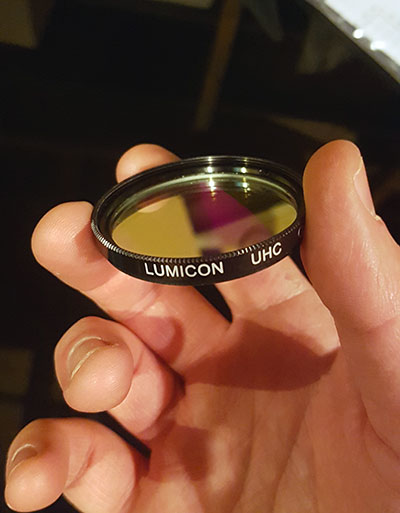Lumicon UHC Filter
The Lumicon UHC filter was designed to better observe and photograph nebulae. The filter passes three selective emission lines, two doubly ionized oxygen lines (496nm and 501nm) and H-beta at 486nm.
The effects of city light pollution and skyglow from a bright moon are reduced due to the selective bandpass qualities of the Lumicon UHC Filter. Offically referred to as an “Ultra High Contrast Telescope Filter”, the model I received is listed as the UHC Gen 3.
Lumicon UHC Filter from Farpoint Astro (Round Mounted 48mm).
This review is in progress, please return again soon for my full review. Until then, have a look at what others are syaing about the Lumicon UHC Filter on Cloudy Nights, and Stargazers Lounge.
Lumicon UHC Filter for Astrophotography
When Farpoint Astro approached me about reviewing one of their products, I immediately requested to review the Lumicon UHC filter. Emission nebulae such as the Lagoon Nebula and Omega Nebula are some of my favorite astrophotography targets to photograph, and these targets are what the Lumicon UHC filter was designed for.
I chose to review a 2″ UHC filter, to test with a one-shot-color dedicated astronomy camera, the ZWO ASI294MC Pro. The 48mm filter threads on to the nose piece and adapter on my camera, and I can easily insert the imaging train into the focus draw tube of my telescope.
The Lumicon UHC filter includes a data sheet that displays the unique emission bands transmission. The data sheet gives me a visual representation of the transmission percentage, and the exact wavelengths that this filter allows to pass through in the visible light spectrum.
Lumicon uses an in-house spectrometer to determine the emission band isolation and light pollution blocking abilities of the filter.
The Lumicon UHC Filter data sheet.
As you can see, the light that the Lumicon UHC filter allows to pass through is isolated to roughly 486nm-514nm. There is a tiny amount of light passing through at the 656nm line (H-alpha), but at less than 1 percent, I doubt this wavelength will be recorded at all in my images.
The powerfully beautiful and dramatic H-beta wavelength sits at 486.1nm on the light spectrum, and this is where nebulae that are rich in ionized hydrogen reside.
When it comes to astrophotography, the H-beta line is weaker than the popular and effective H-alpha wavelength. However, the H-beta line is useful for visual detection of longer red wavelengths of light that are difficult to observe by eye.
This quality will go untested for me personally, as I will only be using the Lumicon UHC filter for astrophotography. Those that choose to use the filter for visual observation of certain nebulae would be able to confirm this.
This data sheet was very interesting to me, and lead to further exploration into advanced filter bandpass technology and their uses. Seeing a list of the exact transmission lines for known light pollution sources was of particular interest to me.
I have used several light pollution filters for astrophotography over the years, yet have not looked into the exact culprits of “bad light” in such great detail until now.
The Lumicon UHC is an effective light pollution filter.
Light Pollution Transmission Lines
- 405nm
- 436nm
- 546nm
- 558nm
- 570nm
What effect do these blocked wavelengths have in your astrophotography images? Have a look at the wavelengths of light that a common high pressure sodium streetlamp emits.
The light wavelengths emitted by a typical city streetlight (older non-LED HPS lamps).
Out of the camera vs. color balanced
The photo below shows the stacked image I created using 28 light frames on the Whirlpool Galaxy. The images were 3-minutes each using a ZWO ASI294MC Pro color camera through a William Optics RedCat 51 refractor.
Using this camera you may notice that the images have a noticeable green cast to them, which is typical of this camera with its RGGB CMOS sensor. However, the Lumicon UHC filter helped to create contrast between my deep sky target and a washed out city sky.
The lower image shows the same data, after using a color correction technique in Adobe Photoshop. The RGB channels were balanced using a black point of 33, 33, 33, and white point of 248,248,248.
In my experience, the Lumicon UHC filter puts a noticeable red cast on my broadband RGB images from the city. This is after applying my standard color balancing routine to set the black and white points.
It’s important to remember that filters like the Lumicon UHC were designed primarily for emission nebulae targets, not galaxies. The bandpasses associated with emission nebulae are intact, but much of the visible spectrum is blocked.
Broadband galaxies are not the Lumicon UHC filters strong point.
Bright stars glow with a red hue to them, regardless of their composition and color (blue-white stars appear pink). This is something I am accustomed to seeing when photographing objects in true color RGB from my Bortle Class 6 backyard sky using a strong light pollution filter.
The data acquired using the Lumicon UHC Gen 3 filter remind me of the images shot using the SkyTech CLS-CCD filter. For this reason, it is most useful for you to see my results using this filter on an emission nebula target.
Please come back soon for those results.




